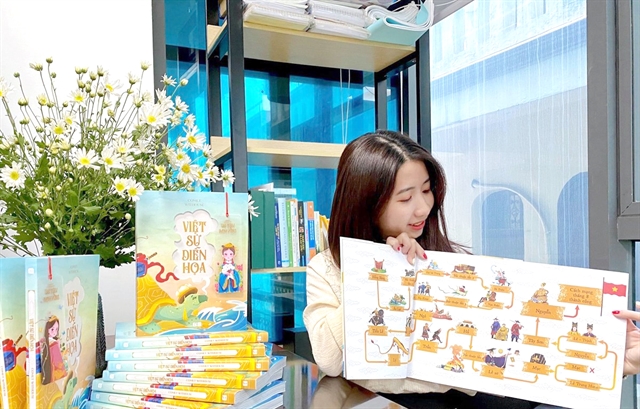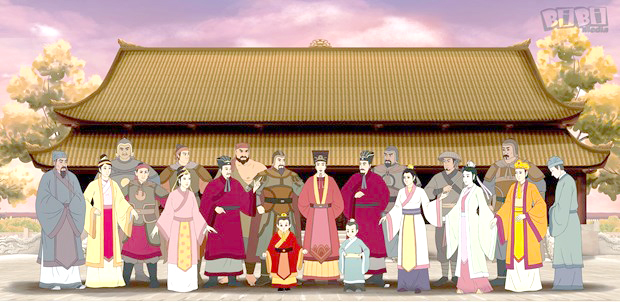 Features
Features

Đặng Thanh Huyên is the author of the colourful Vietnamese history artbook ‘Việt sử diễn họa’, the artist behind the historical animation series ‘Hào khí ngàn năm’ (Thousand years of pride) aired on National Việt Nam Television VTV and is the co-administrator of ‘Đại Việt cổ phong’ (The great Đại Việt), a Facebook group on history research.
Textbooks are no longer the only way to learn about history, as much can now be picked up via visuals like movies and photos or on social media groups.
Đặng Thanh Huyên actively uses all of these sources. She is the author of the colourful Vietnamese history artbook Việt sử diễn họa (Việt Nam History Through Drawings), is the artist behind the historical animation series Hào khí ngàn năm (Thousand years of pride), which aired on Việt Nam Television (VTV), and is the co-administrator of “Đại Việt cổ phong” (The Great Việt ancient customs), a Facebook group on historical research.

|
| PUBLISHED WORK: Đặng Thanh Huyên and her first book, ‘Việt sử diễn họa’. Photo Đặng Thanh Huyên |
After the 2,000 episodes of Hào khí ngàn năm finished airing on VTV1 and VTV3 in 2018, most have since appeared in some shape or form on YouTube channels, where they always collect tens of thousands of views.
It was the first project Huyên participated in after graduating from university, creating a foundation of her passion for Vietnamese historical clothing and history. She also co-manages the “Đại Việt cổ phong” Facebook community of over 130,000 members.
The young woman studied land management, as her parents wanted her to have a stable occupation.
“I’ve loved drawing since the seventh grade and have never stopped,” she said. “I’m always drawing and drawing, despite my parents’ disapproval.”

|
| DETAILED DESIGN: The background and characters in the series on the Trần Dynasty. Photo Đặng Thanh Huyên |
She found a job in the arts industry that both pleased her parents and gave her a livelihood. It led to her drawing the background art for Hào khí ngàn năm, specifically those on Sỹ Nhiếp, Dương Thanh, and Dương Đình Nghệ (well-known figures during the northern dominated period) and some prominent emperors of the Lý and Trần dynasties.
Her role was to draw landscapes, interiors, battleships, and armour, among other things. It required meticulous research on the architecture and decorative items of the Lý and Trần dynasties, like curved roofs of palaces, which are different from those of the Lê and Nguyễn dynasties.
She feels fortunate to know what she wants to do in life.
“If you don’t know what you want to do, then I can’t really give you any advice, but I think you should keep doing what you already do well instead of daydreaming about something else,” she said. “Keep improving and following what you’re good at, and stay patient and be willing to learn.”
Nguyễn Đức Lộc, founder of Ỷ Vân Hiên, a project on traditional clothing and a clothing designer for historical movies and music videos, is excited about how young people are taking more of an interest in historical costumes.
“The more research I do the more I find clothing to be the quintessence of our entire country,” he said. “Vietnamese people have our own unique aesthetic.”
To gain a holistic understanding of her subject when writing Việt sử diễn họa, Huyên shied away from being overly creative and instead tried to remain true to the history of each period. The book covers the original establishment of the nation until the fall of feudalism.

|
| An illustrated timeline of Việt Nam's history by Huyên. |
She conducted research and pored over historical documents like Đại Việt sử ký toàn thư (Complete Annals of Đại Việt), An Nam truyện (Tales of An Nam), Việt Nam sử lược (Precise History of Việt Nam), while also reading research papers and works translated from Chinese she found via the Facebook group.
At times during her research, Huyên came upon inaccurate illustrations of certain periods, which helped her reflect on the subject matter and dig a little deeper.
When she researched and began drawing, she recognised that Vietnamese culture is very much different from Chinese. For instance, Chinese collars are higher and tighter to keep out the cold, and Chinese men during the Qing dynasty often shaved the front half of their head and braided the back, while upper class men in Việt Nam just let their hair grow or shaved it all.
“To encourage young people to be more enthusiastic about studying Vietnamese values, researchers, institutions, and the media need to point out our national identities and cultural values,” said Lý Tùng Hiếu, cultural researcher and professor of cultural studies at the HCM City University of Social Sciences and Humanities.
Huyên finished the book in just over a year, and also draws historical characters to post on Facebook.
She also shares short historical stories and illustrations on her Facebook page “Comet Withouse”. Her latest project takes a look at the jewellery and outfits of the Nguyễn Dynasty, as her passion for art and history lives on. VNS




